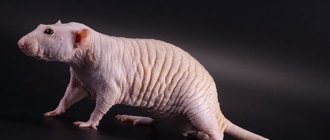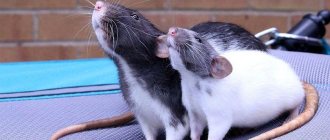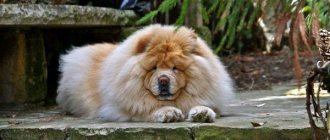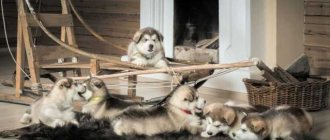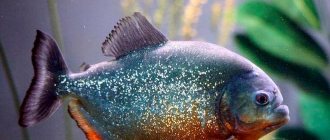- Wild animals
- >>
- Mammals
Contrary to popular stereotypes, a rat can be not only a minor pest and a carrier of especially dangerous diseases, but also a real pet, causing affection among all family members. Especially when it comes to ornamental animals! The Dumbo rat seems to be created to live with a person!
Care and maintenance at home
Caring for tame animals is not difficult.
They take up very little space, and caring for dambos does not require any expense. To ensure a comfortable existence for pets, you should take into account some features of the life of eared babies. Dumbo rats are inquisitive and intelligent. They are superior in intelligence to hamsters and guinea pigs. They waddle like penguins. Their physique does not allow them to run fast, but the animals take walks and mark their territory.
Owners need to take into account that while traveling around the house, rodents will taste everything they come across on the way. Walks must be supervised; animals spend most of their time in cage houses.
Housing for one pet can measure 60 cm in width, length and height. An open aquarium is not suitable, as animals can get out of it. High jumping half a meter is not a record for them. A wire cage with a plastic tray and shelves will be especially cozy if you put a house in it for a relaxing holiday.
Rodents love to be alone and feel protected. The bottom is covered with wood filler; sometimes napkins are spread underneath for ease of cleaning. It is preferable to use shavings, not sawdust, which enter the animal's respiratory tract.
Hanging cups and nipple drinkers must be installed at a sufficient level taking into account the size of the pet. Dry and liquid food are placed in different bowls. A separate corner is allocated for a tray with filler. They won’t let your pet get bored and provide daily loads of stairs, a hammock, and a tunnel.
It is recommended to install the cage with your pet on a small hill up to 1 m from the floor. It is better to choose a place away from bright light and radiation sources
It is important to provide protection from drafts, loud sounds, overheating or hypothermia
The temperature comfortable for pets should be about 20°C, air humidity 50% or more. On hot days, spraying the home or a container of water near the cage helps combat dryness, which is harmful to the breathing of rat pups.
To ensure full life support for pets, several rat pups are bred. Same-sex individuals will not be bored; opposite-sex individuals will bear offspring.
The cage is cleaned as needed, 1-2 times a week. The appearance of an unpleasant odor is a signal to disinfect the home. Removing food residues and replacing litter will help maintain the sanitary condition of the home, which affects the pet’s well-being.
Dumbo rats carry out hygienic procedures independently - they wash themselves and clean their fur. Help is required in regularly shortening growing claws. It is recommended to occasionally bathe pets in heated water. For the fur you need a special shampoo from the pet store.
The Dumbo rat does not like the intrusive attention of household members; communication with other pets should be limited. At the same time, it is a social animal, capable of appreciating communication with humans, becoming attached to its owner, and showing boundless trust in those who show it care and affection.
Training in the form of a game brings joy to the animal, which can learn to find a treat, overcome barriers, and fetch objects. Weasel makes the little rat a loyal and affectionate companion.
Feeding
These pets are quite unpretentious in their choice of food, but are not omnivorous, like ordinary ones. Decorative rats are very gentle creatures, often having intestinal problems and allergies. Its menu should include:
- grain base - it is better to purchase a special mixture for rodents in pet stores. It should make up 60% of the total diet. You can also feed with unprocessed pumpkin, flax or sunflower seeds;
- proteins - occasionally (1-2 times a week) give a little meat (raw or boiled), chicken, yogurt, cottage cheese, eggs will benefit your pet;
- herbs - parsley, cilantro, dandelion, dill, plantain, radish tops;
- vegetables and fruits (preferably boiled) - apples, bananas, carrots, white cabbage, cucumbers, tomatoes, pumpkin, eggplant, potatoes. Citrus fruits must be treated selectively - they can cause allergies in your pet;
- delicacies - grain sticks, nuts, dates, berries, dried fruits, raisins, crackers (unsalted only), unsweetened cookies, boiled pasta, boiled shrimp and seafood.
It is necessary to give fish oil and specialized vitamins. Animals are fed 2 times a day: morning and evening. The exception is pregnant rats - they are fed 4-5 times a day. If you adhere to the basic requirements for what to feed your rat Dumbo, he will be healthy and cheerful.
Important! If your pet refuses to eat for 1-2 days, you should immediately show him to a veterinarian!
These pets are quite unpretentious in their choice of food, but are not omnivorous, like ordinary ones. Decorative rats are very gentle creatures, often having problems with the intestines and allergies.
Its menu should include:
- grain base - it is better to purchase a special mixture for rodents in pet stores. It should make up 60% of the total diet. You can also feed with unprocessed pumpkin, flax or sunflower seeds;
- proteins - occasionally (1-2 times a week) give a little meat (raw or boiled), chicken, yogurt, cottage cheese, eggs will benefit your pet;
- herbs - parsley, cilantro, dandelion, dill, plantain, radish tops;
- vegetables and fruits (preferably boiled) - apples, bananas, carrots, white cabbage, cucumbers, tomatoes, pumpkin, eggplant, potatoes. Citrus fruits must be treated selectively - they can cause allergies in your pet;
- delicacies - grain sticks, nuts, dates, berries, dried fruits, raisins, crackers (unsalted only), unsweetened cookies, boiled pasta, boiled shrimp and seafood.
It is necessary to give fish oil and specialized vitamins. Animals are fed 2 times a day: morning and evening. The exception is pregnant rats - they are fed 4-5 times a day. If you adhere to the basic requirements for what to feed your rat Dumbo, he will be healthy and cheerful.
If the owner is interested in his pet living as long and healthy as possible, the following products should be avoided:
- chocolate and products containing it;
- other sweets;
- sausage and frankfurters;
- canned food for people;
- raw beans and other legumes;
- cheeses (especially blue and salted);
- soda;
- sprouted potatoes;
- Brussels sprouts and red cabbage;
- green bananas;
- spinach;
- beet;
- fatty and salty foods.
What to name the animal
You shouldn't give your pet the first name that comes to mind.
It is advisable to choose names for your pet that will highlight its individuality. To choose the right one, you can rely on the recommendations of experienced rat breeders.
- There is no need to rush to give your Dumbo rat the first name you like. You need to take a closer look at the pet, observe it, and note its characteristic behavioral features.
- Each pet is special to its owner and has the right to a “special” name. Therefore, you should not stop at the usual names for rats, but choose an original one.
- If there are several animals, they can be given names from the same category. For example, the names of the planets are suitable.
- Hints in choosing a name can be found in fairy tales, cartoons or nursery rhymes.
It is important to choose a name that can be changed to a diminutive. This is what the owner will most often call his charming pet with big ears.
Dumbo the rat is one of the best pets. Communication with him is always interesting and evokes a lot of positive emotions. Taking care of a rodent is not difficult, and food costs are low.
https://animallittle.ru/krysa-dambo.htmlhttps://vplate.ru/krysa/dambo/https://zoolog.guru/domashnie-zhivotnye/gryzuny/krysa-dambo.html
Lifespan
In the wild, the lifespan of a rodent depends on its habitat and rarely exceeds one year. They live as pets for 2-2.5 years.
There are also cases where domestic rats lived up to three years or more. And the Guinness Book of Records notes that the oldest rat lived to the age of 7 years.
The popularity of rodents as pets increased dramatically with the release of the third Harry Potter book. In The Prisoner of Azkaban, there was a certain wizard who lived in the guise of a rat for 12 years. Fans of the world of magic who believed in the long life of pets were in for a slight disappointment. Rats bought at the height of Pottermania lived, like ordinary ones, for 2-3 years.
How long rats live at home is influenced by quality of life, nutrition and genetics. To prolong a pet’s existence, you need to provide it with favorable living conditions. The common belief that rodents can live in any conditions is partly true. However, poor care will certainly affect life expectancy.
How long do dumbos live?
Under good living conditions, the average lifespan of a Dumbo rat is 3-3.5 years. However, premature death of the animal can occur as a result of certain diseases. Representatives of this breed are susceptible to the following diseases:
- conjunctivitis;
- mycoplasmosis;
- neoplasms;
- helminthiasis
To avoid adverse consequences for the health and life of your pet, it is important to know the main symptoms indicating malaise: decreased activity, runny eyes and nasal passages, refusal to eat and drink, fur sticking out in different directions, prolonged solitude in a house or in the corner of a cage.
Differences from wild rats
While ornamental rats are very similar to their wild relatives, there are significant differences between them. The most noticeable difference is the appearance. Random mutations (mostly in color) can occur in the wild, but are rare.
Decorative rats are calmer and less aggressive towards humans due to breeding and, as a result, the constant selection of producers with the desired set of behavioral qualities. However, ornamental rats, like any other domestic animals, can become wild and over several generations produced in natural conditions, their behavior and attitude towards humans can become indistinguishable from initially wild rats. This phenomenon is regularly encountered by rat lovers who are engaged in catching colonies or families of decorative rats that find themselves on the street.
Decorative rats have greater body weight and fertility. They are less afraid of new products, they have a calmer reaction to light and sound, and neophobia is less developed. Wild rats are mainly nocturnal, sometimes going out during the day in search of food. In domesticated rats this is not so pronounced. In a fight, wild rats produce sharper screams than domestic ones. In addition, a wild rat that loses a “battle” almost always runs away from the winning one, while domesticated rats can behave differently after a fight.
Domesticated rats live longer than wild ones. This is because kitty rats are protected from predators and always have access to food, water, shelter and veterinary care. Their average lifespan is approximately 2–3 years, unlike wild ones, which on average live less than 1 year. Wild rats have larger brains, hearts, livers, kidneys and adrenal glands. However, decorative rats, like wild ones, are susceptible to many different diseases, among which a special place is occupied by the respiratory syndrome of mouse-like rodents (respiratory diseases of various etiologies), as well as various neoplasms (tumors of the mammary glands, brain, etc.).
Colors
The color of animals of this breed variety, as well as the length and quality of the coat within the species, can vary greatly. Most often there are individuals with short, velvety, straight hair in gray, white, black and chocolate colors. Rare colors of dumbo rats are Siamese, amber, topaz, and mosaic (tricolor).
Amazingly beautiful Dumbo rat of blue mink color. You can find it only from large breeders at a price that is quite high for decorative rats.
Scientists, by crossing rodents of the Dambo breed variety with decorative rats of other breeds, managed to obtain new subspecies that deserve the attention of amateur rat breeders.
Dumbo rats have the following subspecies:
- Sphynx - can be white, blue, chocolate and black. Their body is completely devoid of vegetation. There is some hair on the back, paws and head. There are either no mustaches at all, or they are very small and curled upward. Suitable for people with allergies;
- rex, on the contrary, has thick, wavy and fairly stiff hair;
- Husky is a chameleon rat. Only it has the amazing ability to “bloom” - to change color with age. Babies are born of a standard color - black, gray, red, etc., but with age, their fur is diluted with white hairs - so that, born black, a rat pup, having matured, turns into a snow-white miracle. Their ideal color is “salt and pepper.”
Experienced rat breeders know how long domestic Dumbo rats live. And you won’t be able to please beginners with the length of your pet’s life – you need to immediately get used to the idea that your pet will stay with you for about 2-4 years. Thanks to good care and nutrition, many manage to extend their life by a year and a half, but no more.
Description of character
Rats are intellectuals with a soul and are very attached to their owner. They need communication and attention, otherwise they will wither away. The character of domestic rats of the Dumbo breed is calmer and more reserved than the rest. They are not that active. Very sociable, freedom-loving and cheerful. Experts advise taking rat pups not from pet stores, but from breeders, when they are very young, then the pets grow up to be affectionate and trusting little animals. Dambiks are very clean. If their house is dirty, they take care of cleaning themselves.
Making a home for a rat
At home, rats can be kept in pairs, packs or alone. Rats are polygamous; if you are not going to sell or give away pups later, you should not have a male and a female, much less put them in the same cage. Caring for the cubs will complicate your life in any case, since rats are not particularly picky when choosing a partner. A male and a female can only contact each other for the purpose of reproduction. However, they are pack animals that require companionship.
Cell
The housing material must be made of metal. Wooden cages for rodents have performed very poorly and are practically not offered for sale. The cage for rodents should be spacious. It is not recommended to purchase low cages, as some individuals like to climb the upper bars. The most common and acceptable size for a cage is 60x40x60 cm.
You need to pay attention to the distance between the bars of the gratings. They should be no more than 12 mm
The rods themselves must be completely covered with enamel and not have chips or peeling of the coating anywhere. The bottom of the cage should be smooth to minimize subsequent injury to the pet. It is worth taking care of a tray with high sides so that waste does not fall on the surface of the floor or table. Collapsible cages with large doors received positive feedback.
Toys
It is imperative to equip the cage with a small house. For pets, it will look like a hole in which they will hide and sleep. It would be best to make its bottom soft. Another favorite place to relax may be a hammock. It can be hung between the bars of the cage or installed separately. Other useful and interesting toys for rats include various colored tunnels, bridges, wheels, swings, balls and even edible figures.
It is recommended to purchase a nipple drinker. It is most convenient for pets and owners. When choosing between floor-standing and hanging bowls, it is better to give preference to hanging ones. You can put both dry food in them and use them for liquid food. The best filler is corn. Wooden sawdust provokes allergies, and napkins require regular cleaning. Do not use paper with printing ink as filler. It can simply poison rodents.
It's a good idea to create your own mini rat park. To do this, you need to plant wheat in a small tray with soil. After it germinates, you need to place it in a cage. The pet will be happy to bask in it.
Reproduction
How to determine gender?
Males can be distinguished from females by their enlarged testicles, which are clearly visible already at the age of 2–3 weeks. In female decorative rats, the rudiments of nipples are observed during this period of life.
Mating
Sexual maturity occurs early - at the age of 5–6 weeks. But individuals from 8 to 10 weeks are recommended for mating. In order to get offspring, it is enough to leave the male and female in the same cage for a couple of days. But you need to understand that fertilization is possible only if the female is in heat. It occurs regularly at intervals of 4–7 days.
Pregnancy
From the moment of fertilization to the birth of rat pups, no more than 23 days pass. On average, birth occurs between 21 and 23 days. The female's pregnancy becomes noticeable starting from the second week after fertilization. The animal’s physique plays a big role in the appearance of the first signs. If the female is thin, the rounded tummy will be noticeable faster than in a fat and large rat.
A litter can contain from 8 to 15 pups. During pregnancy, the female needs increased and nutritious nutrition. Bloody discharge and the female's desire for privacy will indicate the approaching birth . Often the dumbo rat begins to prepare its nest: it cleans and arranges it. Childbirth lasts no more than 3 hours.
How to care for newborn rat pups
The female Dumbo takes good care of her offspring.
During this period, the owner must follow several rules:
- do not pick up baby rats;
- take care of the cleanliness of the cell;
- provide the mother with good nutrition.
Rats can be handled once they are 14–15 days old.
Housing for a rat
To provide good care for your rat, you must first ensure that it has a comfortable and cozy home. Since these animals are usually kept in pairs, the cage needs to be spacious. In a cramped space, pets will not be able to move and play freely. Low mobility will negatively affect their health.
Choosing the right cage
For two dumbo rats, a multi-tiered structure made of metal lattice is suitable. The minimum cage size is 60x40 cm. The recommended height of the home is from 50 cm, but the higher the better. In the lower part of the home, pets eat and have fun, and the second tier is reserved for a relaxation area.
If desired, you can also arrange a third level, where you can hang hammocks. The floors are connected to each other by tunnels or stairs.
The cage must be equipped with a removable plastic tray.
When purchasing, you need to pay attention to the fittings. All parts must be made of metal, otherwise they will quickly become unusable under the pressure of a rodent’s teeth
Some owners use an aquarium with a lattice lid to keep Dumbo rats. However, this is not the most suitable home. The glass container is poorly ventilated. In addition, to clean the inside, you will have to take out all the equipment, then clean out the dirty filling and wash the bottom.
If you use a cage, doing all this becomes much easier - you only take out the tray along with the bedding.
Correct placement of the cage
The cage should not be in a draft, nor near a heating radiator, on a windowsill, or on the floor.
It is better to place a cage with Dumbo rats in the living room or hallway, but not in the bedroom, because rats are active and noisy at night. You can place your pets’ home on an insulated loggia, provided that the air temperature there does not go beyond +18…+26°C. In the fall, it is better to move the cage into the apartment.
Filler selection
The health and life expectancy of your pet depends on the quality of care. The wrong choice of filler often leads to allergies in Dumbo rats. For example, shavings from coniferous trees are not suitable due to the high content of essential oils.
Dumbo rat fillers:
- corn - made from crushed cobs;
- compressed wood pellets;
- paper.
These types of fillers have a number of advantages - safety, good absorption capacity, hypoallergenicity.
Hay bedding is absolutely not suitable, as the rat can get hurt; in addition, dried grass does not absorb moisture well and does not mask the smell. Silica gel is also not suitable - it is possible that the pet will want to taste it, and this is dangerous. Newspapers should not be used as bedding - they contain printing ink that is harmful to health.
Home improvement
The cage can accommodate not only ladders, tunnels, but also other equipment. This should leave enough free space for movement.
Holiday house
The most important attribute of a cozy home is a house. When choosing, you need to take into account the size of the animal as an adult, that is, it is bought for growth. The body length of a mature individual reaches 20 cm. The animal should be comfortable inside. The preferred material is durable plastic, as it is easy to clean. It does not absorb unpleasant odors and is easy to clean.
Other inventory
Several feeders are usually placed on the ground floor. It is advisable to choose heavy containers, such as ceramic ones, so that rats cannot knock them over. One feeder is for grain mixture and the other is for wet food.
You will also need a drinking bowl. They come in two types - regular and nipple. It's better to choose the second option:
- such a drinking bowl cannot be turned over;
- the water stays fresh longer;
- it doesn't take up space.
The nipple drinker is attached to the bars on the outside of the cage, and the spout is placed inside. To drink, the rat touches the ball with its tongue, and water begins to flow into its mouth. This drinking bowl does not require complicated maintenance. It is enough to wash it once every few days and fill it with clean water.
Dumbo rats have a mischievous nature and are very active pets. Therefore, ropes need to be placed in the cage for them to climb. You can attach a running wheel to one of the walls, but it should not be lattice. The pet will be injured if its tail gets caught in the hole while running.
A hammock is another attribute of the home. Rats just love to hide inside and swing around.
Training Basics
Small and cunning Dumbos are happy to follow simple commands in order to get a treat. But you should not force the animal to perform complex tasks from the very first days. Start with the basics:
- Get your rat used to being handled. This step is the most important, but the most exciting for new rat breeders. Do not make sudden movements, do not grab or squeeze the rat - it may get scared and bite you. Calmly extend your open palm to the animal and let the pet know that you do not pose a danger to its life. You need to devote at least 2 hours to this every day.
- Learn to respond to a name. Every time you open the cage, pick up the rat, pet it or give it a treat, say its name clearly. Do not use diminutives and do not go through different nicknames. The animal must build a clear association between the sounds being spoken and the result obtained.
- Train your rat to return to the cage. You should move on to this step when the animal clearly remembers its name. Open the cage, step back a few steps, give your pet a treat and call him over. Let your pet run up and take the food from your hand. Allow him to return to the cage on his own, and when she enters, say the command “home!” After a few repetitions, Dmbo will learn to come home and leave the cage on command.
Today it is difficult to surprise anyone by keeping unusual pets in an apartment, and more and more people are looking for an alternative to the usual cats and dogs. Dumbo rats are an excellent option for those who want to get a smart and entertaining pet that does not require large financial outlays.
Breeds of decorative rats
The breed of rats is determined by their body structure and fur.
The definition of a breed of decorative rat is completely different from what is commonly believed in relation to other domestic animals. The concept of “breed” in dogs and cats implies the production of offspring that inherit from their parents the features of appearance, basic mental and character traits.
It's different with rats. The offspring inherits parental characteristics only with some probability. Therefore, the breed is determined by two criteria:
- body structure;
- quality of fur.
There is also a clarifying classification of these rodents based on coat color.
7 breeds of decorative rats have been standardized:
- standard;
- rex;
- satin (otherwise called “satin”);
- sphinx (hairless);
- dumbo;
- tailless;
- downy
Standard
It is representatives of this breed that most people think of when they hear the phrase “decorative rat.”
The most common breed. It is with this that the term “decorative rat” is associated. People who are not interested in breeding these rodents imagine them this way.
Characteristics of the breed:
- short glossy fur;
- elongated body (maximum - up to 24 cm);
- hairless, thickened at the base, long tail;
- small rounded ears;
- above the eyes there are thin short vibrissae (stiff hairs, which are called whiskers and eyebrows, are also found in cats and dogs).
Rex
Rex rats look more sophisticated
Surprisingly beautiful and impressive rodents with curly fur and curled antennae. They are distinguished by a matte shade of the “fur coat”, which is quite thick and tough. There is a small amount of hair on the belly. Some representatives of the breed may have them completely absent.
Character traits:
- shorter mustache than other relatives;
- wool hardness;
- a small number of vibrissae.
Satin
Satin rats are very pleasant to pet
Decorative rats of the satin breed attract with their intelligence, smoothness and silky fur. These pets are pleasant to pet, which they really enjoy. Males and females can reach a length of 30 cm. The average weight of a male is 600–800 g, a female is 300–450 g. The physique is similar to the “standard” breed.
Character traits:
- short shiny fur;
- wide variety of colors;
- bare legs and tail.
Sphinx
This breed is not afraid of shedding
Sphynxes are spectacular decorative rats with a complete absence of hair on all parts of the body. They attract with their intelligence, friendliness and exoticism. The breed standard allows for thin and short fluff on the cheeks, paws and groin area. The mustache can be spectacularly curled, like that of the Rex breed. The lack of hair determines the characteristics of caring for these pets. They must be protected from drafts and sharp-edged objects.
Dumbo
The main distinguishing feature of the Dumbo breed is its charming saucer ears.
A relatively young breed, bred in the mid-90s of the last century. Its representatives have several distinctive features:
- rounded, rather large ears, located closer to the cheeks than in rats of other breeds;
- relatively small sizes: 15–20 cm in length;
- wider skull than other decorative rats;
- The body shape is pear-shaped, thickening towards the tail.
The breed standard allows for some pointed ears, but two types of shapes are considered acceptable:
- "saucer";
- “tulip”, with the edge of the ear slightly lowered down.
Tailless
Tailless rats are more similar to hamsters than to their relatives in the rat kingdom
The breed was obtained by accident, the result of an unintentional mutation. The name of the breed is “speaking”, informing about its characteristics. Rats are born tailless, with a pear-shaped body. A characteristic feature is modified lumbar vertebrae. This determines the stockiness of the physique and the roundness of the croup.
Tailless rats with different eye colors are often found. The fur of representatives of the breed is short, slight curling is acceptable. The color can be very different, including spots.
Downy
The downy rat lives up to its name
A distinctive feature of the breed is its short fur, through which the skin of the body is visible. These rodents have frequent molting, during which different parts of the body are periodically exposed. The color of the fur can be very different. The hairs are longer and stiffer on the face and belly. Vibrissae short and slightly curled.
Varieties
Currently, breeders have bred quite a lot of varieties of dumbo rats. However, 6 main types are most popular among breeders.
Sphinx
The main distinguishing feature is the complete absence of wool. The skin of healthy pets is pink, pleasant to the touch, and has numerous folds. In rare cases, sparse fluff is observed on the muzzle and in the groin area. Pets' whiskers are underdeveloped or absent altogether.
Due to the lack of fur, sphinxes are very sensitive to environmental conditions and easily become hypothermic. To prevent your pet from freezing, the temperature in the room with the cage should not be lower than +21-22°C.
Dumbo Rex have a thick coat that is wavy or curly. The wool is very pleasant and soft to the touch. In rat pups that have not reached the age of one month, the hairs do not curl, but stick out in all directions. Whiskers, like wool, are slightly curly.
Manx
Manx rats are distinguished by the complete absence of a tail. This makes them neater than other varieties of dumbos. However, this feature brings many problems to the animals.
How can you tame it?
Funny animals easily make contact with people and are quickly trained
Before learning complex tricks, the animal must be carefully accustomed to handling. The pet should be held in the palm of your hand and stroked for at least 2 hours a day
When contacting an animal, you must constantly pronounce its full name, trying not to use a large number of synonyms.
Trainers recommend calling the animal by name to its favorite treats.
An important point in training is to teach the rat to return to its place in the cage and independently leave it when the owner calls. After a short tactile and emotional contact, the animals begin to trust their owner.
During the game, animals can bring small objects, find tasty food, overcome low obstacles, delivering a lot of positive emotions to their owners.
Some individuals can even select a given object, stand on their hind legs and take shiny objects out of boxes.
Life expectancy of a decorative rat
Decorative pet rats do not live long, the average lifespan is 2 years. With proper care and a balanced diet, the animal can delight with its presence for up to 4 years, but this is already an advanced age for such an animal. The short life expectancy is compensated by the high fertility of individuals and their high degree of adaptation to any conditions. The maximum age of a domestic rat recorded by amateurs is 7 years.
Domestic decorative rats are rodents; they are cared for and kept in metal cages, because they are the strongest and most durable. It is better not to keep animals in plastic and wooden structures. It is also not recommended to place them in aquariums - they are difficult to clean, and the animals jump to a height of 40-50 cm and can escape. The house is installed in a place where there is no direct sunlight and draft, from which a rat can contract pneumonia. There is no need to place a home near the battery - dry air is harmful to animals. Optimum temperature +18-20°C.
For a decorative rat, the cage should have a size of 60x40x30 (for growth); often the house has two floors. Inside the home you need to install:
- a plastic tray with filler (preferably dry wood granules. Small sawdust can cause allergies in rats by getting into their eyes and nose. Newsprint contains harmful substances and is not suitable for use as bedding);
- stairs and tunnels, a wheel (animals love to play);
- plastic house for privacy;
- mineral stone for rodents (they sharpen their teeth);
- drinking bowl;
- 1-2 bowls;
- a cloth for sleeping or a hammock.
